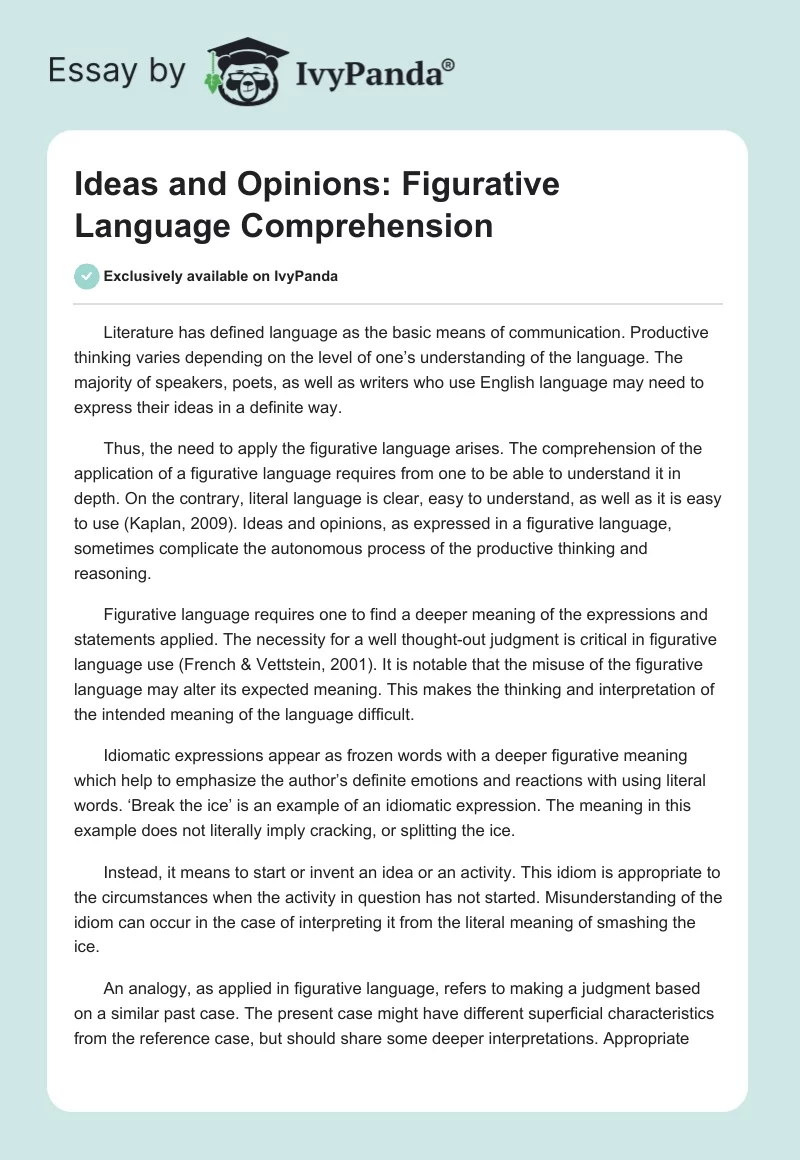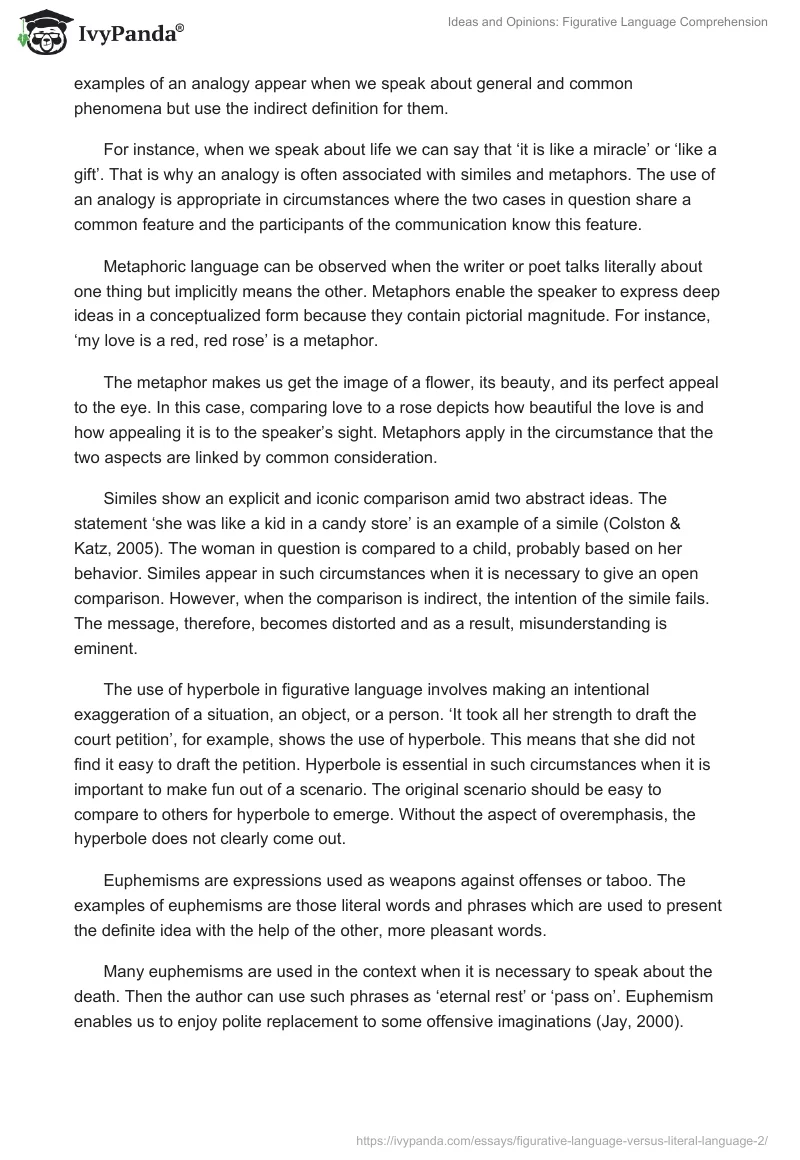Literature has defined language as the basic means of communication. Productive thinking varies depending on the level of one’s understanding of the language. The majority of speakers, poets, as well as writers who use English language may need to express their ideas in a definite way.
Thus, the need to apply the figurative language arises. The comprehension of the application of a figurative language requires from one to be able to understand it in depth. On the contrary, literal language is clear, easy to understand, as well as it is easy to use (Kaplan, 2009). Ideas and opinions, as expressed in a figurative language, sometimes complicate the autonomous process of the productive thinking and reasoning.
Figurative language requires one to find a deeper meaning of the expressions and statements applied. The necessity for a well thought-out judgment is critical in figurative language use (French & Vettstein, 2001). It is notable that the misuse of the figurative language may alter its expected meaning. This makes the thinking and interpretation of the intended meaning of the language difficult.
Idiomatic expressions appear as frozen words with a deeper figurative meaning which help to emphasize the author’s definite emotions and reactions with using literal words. ‘Break the ice’ is an example of an idiomatic expression. The meaning in this example does not literally imply cracking, or splitting the ice.
Instead, it means to start or invent an idea or an activity. This idiom is appropriate to the circumstances when the activity in question has not started. Misunderstanding of the idiom can occur in the case of interpreting it from the literal meaning of smashing the ice.
An analogy, as applied in figurative language, refers to making a judgment based on a similar past case. The present case might have different superficial characteristics from the reference case, but should share some deeper interpretations. Appropriate examples of an analogy appear when we speak about general and common phenomena but use the indirect definition for them.
For instance, when we speak about life we can say that ‘it is like a miracle’ or ‘like a gift’. That is why an analogy is often associated with similes and metaphors. The use of an analogy is appropriate in circumstances where the two cases in question share a common feature and the participants of the communication know this feature.
Metaphoric language can be observed when the writer or poet talks literally about one thing but implicitly means the other. Metaphors enable the speaker to express deep ideas in a conceptualized form because they contain pictorial magnitude. For instance, ‘my love is a red, red rose’ is a metaphor.
The metaphor makes us get the image of a flower, its beauty, and its perfect appeal to the eye. In this case, comparing love to a rose depicts how beautiful the love is and how appealing it is to the speaker’s sight. Metaphors apply in the circumstance that the two aspects are linked by common consideration.
Similes show an explicit and iconic comparison amid two abstract ideas. The statement ‘she was like a kid in a candy store’ is an example of a simile (Colston & Katz, 2005). The woman in question is compared to a child, probably based on her behavior. Similes appear in such circumstances when it is necessary to give an open comparison. However, when the comparison is indirect, the intention of the simile fails. The message, therefore, becomes distorted and as a result, misunderstanding is eminent.
The use of hyperbole in figurative language involves making an intentional exaggeration of a situation, an object, or a person. ‘It took all her strength to draft the court petition’, for example, shows the use of hyperbole. This means that she did not find it easy to draft the petition. Hyperbole is essential in such circumstances when it is important to make fun out of a scenario. The original scenario should be easy to compare to others for hyperbole to emerge. Without the aspect of overemphasis, the hyperbole does not clearly come out.
Euphemisms are expressions used as weapons against offenses or taboo. The examples of euphemisms are those literal words and phrases which are used to present the definite idea with the help of the other, more pleasant words.
Many euphemisms are used in the context when it is necessary to speak about the death. Then the author can use such phrases as ‘eternal rest’ or ‘pass on’. Euphemism enables us to enjoy polite replacement to some offensive imaginations (Jay, 2000).
Colloquialism in figurative language entails the use of clumsy phrases. Such phrases are objectionable in the formal writing (Kaplan, 2009). Examples of such colloquial expressions can be ‘isn’t’, ‘cute’, ‘kid’, and ‘how come’. These phrases are used mostly in e-mails when people try to reflect the peculiarities of the informal communication. The language itself is unpolished and mostly applicable to informal discussions, such as chat rooms.
A cliché is an overused and exhausted expression. First time writers often use it. Thus, the expression ‘as big as an elephant’ belongs to the class of clichés (Colston & Katz, 2005). Clichés are often used to emphasize the statement. Thus, such phrases have the figurative meaning, but they can simplify the communication because their meanings are well-known.
Amphiboly occurs because of grammatical ambiguities in a phrase. It is different from equivocation whereby the ambiguity occurs in isolated words. It is significant to note that the ambiguity is mostly in the grammar, but not in the argument.
Example ‘my kid’s study is good’. The word ‘kid’ can be a child or a goat, while study can indicate the outcome of the act of studying. The phrase is, therefore, vague from both points of view. Thus, carelessness can be intentional and is often used to mislead people.
A ‘flame word’ refers to a word spotted in e-mails. They are majorly used in flame e-mails. Flame e-mails have incited messages. A good example of a flame e-mail is ‘let’s come together, and stop them from grabbing our wealth’. This is a rabble-rousing message which is used to attract the public’s attention.
The figurative language use can be quite challenging given its contextual nature. Ideas in a figurative language are articulated in terms of each other. Literal language, in contrast, leads without recourse to another line of interpretation. The usage of figurative language can present a wide scope of misinterpretations.
A vivid understanding of its deeper meaning is indispensable for enhanced thinking. Figurative language use initiates a deep line of thought, and its use and misuse may render it tricky for others to engage in creative and critical thinking.
References
Colston, H., & Katz, A. (2005). Figurative language comprehension: Social and cultural influences. Mahwah, NJ: Lawrence Erlbaum Associates Inc. Publishers.
French, P., & Vettstein, H. (2001). Figurative language. Malden, MA: Blackwell Publishers Inc.
Jay, T. (2000). Why we curse a neuro-psyco-social theory of speech. Amsterdam, NL: John Benjamin Publishing Company.
Kaplan, K. (2009). GMAT Advanced 2009-2010 edition: Intensive prep for top students. New York, NY: Kaplan Publishing.


